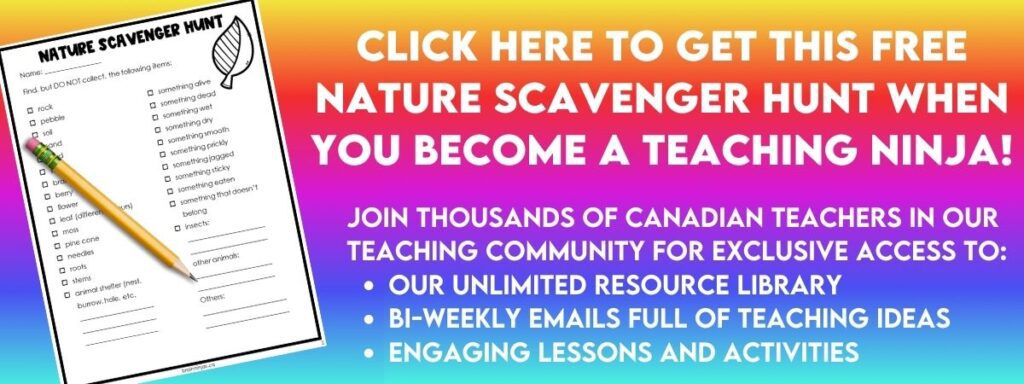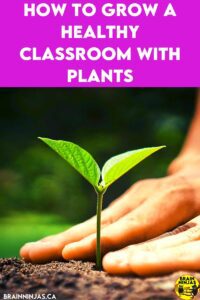
How do you bring nature into your classroom? Or how do you bring your classroom to nature? More and more research shows the benefits of nature to student health and achievement (and yours, too!). Where should you start? We’ve put together a list of things you can do to help connect with nature to create a healthy classroom. Hint hint-they don’t cost money.
Class Plants Create a Healthy Classroom
Growing plants in your classroom is an easy way to bring nature into your class (and they are much easier to care for than a class pet).
A simple plant will do the trick. Try a plant like a Venus flytrap. It allows students to discover how some plants have special needs. Feed it occasionally!
Students can figure out a watering schedule, learn about the amount of water, determine light needs, learn about the soil needs, and the temperature. You can have students care for the plants in common areas of the school. Caring for class plants can easily become a part of teaching about plant needs in many provincial curriculums. Find Plant Experiments in our TpT Store ($USD) or our BN Shop ($CAN).
Grow a bean sprout or nurture a plant through one complete life cycle. Observe the life stages of the plant and the reproductive structures of the plant. Test different conditions to see how plants react. Have students look for seeds in their meals. They can bring them to school for planting or plant them on their own at home to share the results.
Have students make observations about how plants grow. Find Plant Growth Observation Journals in our TpT Store ($USD) or our BN Shop ($CAN).
Turn the Classroom Inside Out
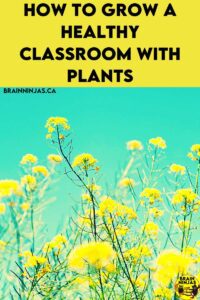
The schoolyard is a great place to connect with nature. Does your schoolyard have trees? Bushes? Flowers? Even one lonely tree counts! Gather around the tree to read, draw or observe the birds and bugs that call it home.
Language Arts
Take the time to go outside and let students read independently or with a partner or even with a small group. Hold a sharing circle. This is a great alternative to having a class discussion and something about the fresh air helps keep the noise at bay.
We wrote this set of Plant Growth Reading Passages to replace a textbook so our students could learn about plants. Find them in our TpT Store ($USD) or our BN Shop ($CAN).
Integrate learning about plants into your lessons with our weekly reading comprehension series. Our Peculiar Plants reading comprehension unit comes with four weeks of reading passages, reading comprehension activities, word studies, and so much more. Find it on TpT ($USD) or our BN Shop ($CAN).
The individual topics are:
Sacred Plants on TpT ($USD) or our BN Shop ($CAN)
Carnivorous Plants on TpT ($USD) or our BN Shop ($CAN)
Invasive Plants on TpT ($USD) or our BN Shop ($CAN)
Xeriscaping on TpT ($USD) or our BN Shop ($CAN)
Math
Integrate math into your adventure outside. How do the shadows of plants differ? What percentage of the schoolyard is covered with trees? How could the space be divided into equal parts? Measure angles between the tree branches and the trunk.
Have students plan and propose ways the school and community could bring more nature in. Get planters, buy flowers, plant trees or calculate the costs of this. Check with your local gardening centre for donations. Involve students in this project with math, writing, and oral presentation skills.
Science
Observe the trees and shrubs during seasonal changes to teach students about the life cycle of plants and the adaptations that plants have to survive. Even observing weeds counts! Pull some weeds and have students dissect them.
Talk about how seeds can be distributed in a variety of ways. Seeds are adapted for these different methods of distribution. You can find Plant Lessons in our TpT Store ($USD) or our BN Shop ($CAN). Another resource explains how plants are sorted. Find Plant Classification in our TpT Store ($USD) or our BN Shop ($CAN).
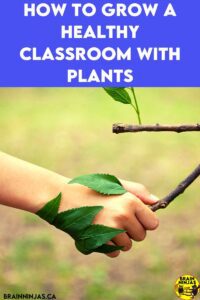
Choose a shrub to observe. How does sunlight affect it? What about the temperature? Observe the leaves. Watch the shrub over a few weeks or months. Find Special Needs of Plants in our TpT Store ($USD) or our BN Shop ($CAN).
Get students to identify and describe the general purpose of plant roots, stems, leaves and flowers. Put a leaf into a plastic baggie and observe what happens inside the baggie over time. Place carnations (or sticks of celery) in jars of different coloured water and watch what happens.
Plants are important to humans and the natural environment. They are used as a source of food or shelter. They play an important role in the environment to prevent erosion, produce oxygen and capture carbon dioxide.
You can learn about plants by exploring different biomes. How do plants adapt to living in the Arctic or in the desert? What happens to plant communities as our climate changes?
Find the whole Plants Unit in our TpT Store ($USD) or our BN Shop ($CAN). You can also this digital review game that uses Google Slides to review everything your students have learned. Find the Plants Interactive Review Game in our TpT Store ($USD) or our BN Shop ($CAN).
Social Studies
Working on mapping in Social Studies? Have students map the schoolyard and the different plants in each area using a legend, compass rose or scale.
Plants are important to Indigenous People all across Canada. Have your students study the location and types of plants that are important to First Nations, Metis or Inuit People in your area with a research activity. It includes everything you need (except blank file folders) to learn about tobacco, sage, sweetgrass, and cedar. Find Sacred Plants in our TpT Store ($USD) or our BN Shop ($CAN).
Health, Physical Education and Art
Drawing in nature can be a great way to teach an art lesson. There are many simple art lessons that can be done outside. Photograph them so you can leave nature outside. Use leaves from different plants to create an art piece. Gather sticks and use them as paintbrushes to create abstract paintings in the sand or mud. Using natural items found in the area to create a sculpture or flat ‘collage’. Have students bring a sketchbook outside and sketch something they see in the natural world.
Combine science and art by creating tree bark or leaf rubbings. We have created lots of different art projects inspired by plants and nature. Find Plants Inspired Art Projects in our TpT Store ($USD) or our BN Shop ($CAN).
Students can use what they’ve learned about plants to creatively design a plant. Find Design a Plant in our TpT Store ($USD) or our BN Shop ($CAN).
Plan a scavenger hunt through the schoolyard with students finding as many natural items as they can. You want to avoid having students collect the items. Get a copy of this nature scavenger hunt in our Resource Library or we can email one to you when you sign up for our email list.
Listen to nature. Find a safe place in the schoolyard for students to sit or lie down with their eyes closed. We say safe because you don’t want to do this where other students are running around or there is traffic. Listen to the sounds of nature. What do they hear? What do they NOT hear?
Neighbourhood Nature Walk
Even in an urban area, there is so much nature. It might be worth driving around the neighbourhood one day after school to scope out potential natural areas for your students to explore.
Students can explore how differences in plant communities are related to variations in the amount of light, water and other conditions. Find Plant Communities in our TpT Store ($USD) or our BN Shop ($CAN).
Take the same walk more than once but have students make observations on different things each time. The first time, have students look for flowering plants. Next, have them observe animals. During the third walk, observe how nature and human infrastructure work (or don’t work) together.
Students can write about what they experience while walking in the neighbourhood. It could be an expository text about what they saw. Write a poem using nature words. Write a simile or metaphor that captures the experience.
Don’t have much nature in your neighbourhood? Have students propose a project to the community to increase access to natural settings. It is a real-world application. Let students experience how they can participate in changing their community.
Nature Activities for Winter
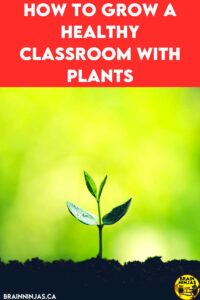
Think you can’t bring nature into the classroom in the winter? Well, it can be much easier to observe birds in the winter without all of the foliage on trees and shrubs. Bird counts are often done in winter for this reason.
Start with bird identification, which is a great tie-in with science. Have students learn about colour, size, wing shape, beak, flight patterns and sound. Your school librarian might have some great bird books and there are plenty of resources online. Doing a bird count is a great way to incorporate math as well by graphing the data of the count. You can do the bird count again in the spring and compare the data.
Walking in the woods in the winter makes it easy to see the different layers of the forest.
Create a Community Garden
If you are very ambitious and have a great team, start a community garden at your school. Your local greenhouse or community league might be able to help. The main thing to keep in mind is who will care for the garden when school is not in session. Include your neighbours and community.
Maybe you are lucky enough to have an established garden. Find out how you can participate. It might be as simple as going for a tour of the garden or learning from one of the gardeners.
Easy Ways to Make Animal Observations
There are many opportunities to observe different animals in the schoolyard. Birds, squirrels and bugs are probably the easiest to observe. Students can observe the physical characteristics of animals.
Observing behavioural adaptations, although will take more time, makes students slow down (so they don’t scare off the animal). How do the animals behave? Why do they think they behave a certain way? What is the adaptation?
Find the Indigenous Connections in Nature
Invite a local Elder or Knowledge Keeper to your class and have them teach students about the connections between Indigenous knowledge and nature. Explore with students the role nature plays in Indigenous ways of knowing. Research traditional plants and how are they used in ceremonies or everyday life. Combine this research with the study of geographical regions as part of Social Studies.
Cure Nature-Deficit
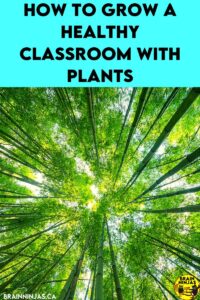
Nature-deficit Disorder is a belief that the lack of time people, especially children, spend in nature affects our health. This idea was coined by Richard Louv in 2005 with the publication of his book, Last Child in the Woods: Saving Our Children from Nature-Deficit Disorder.
Louv is quoted as saying: “It’s a problem because kids who don’t get nature-time seem more prone to anxiety, depression and attention-deficit.” In the last decade, more research has been done on nature-deficit disorder and the link between the disconnection with nature and behaviour and well-being.
Although this is not recognized as a medical condition, think about how you feel when you spend even fifteen minutes in nature. The benefits of taking your students outside can only be positive.
On days we go outside we find students are able to better manage their behaviour, stay on task longer and according to their parents, they sleep better. Sounds like that is the perfect way to grow healthy students!
If you’re looking for more eco-friendly options to bring nature into your classroom, you might want to check out Earth Day Activities as it has many more ideas.
Do You Teach Science?
If you teach in Alberta, we’ve adjusted our plant resources to meet the outcomes for living systems. Learn more here. You might find these posts helpful:
- Engaging Electricity Lessons to Shock Your Students
- Engaging Weather Lessons All In One Place
- How to Learn About Wetlands Without a Pond
- 15 Simple Machines Activities that Will Hook Your Students
- How to Escalate Your Chemistry Experiments
How do you connect nature with your teaching and student learning? What tips do you have? We’d love to hear your ideas. Leave us a comment below.

